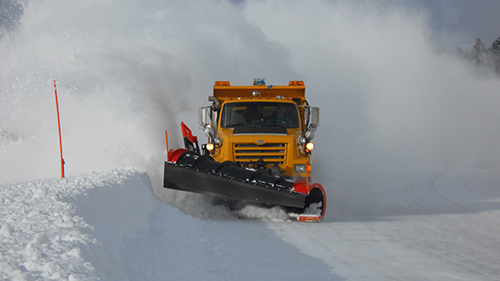- Home
- Administration
- Aeronautics
- Business with WYDOT
- Construction Projects
- Driver License and Records
- Economic Stimulus Projects (ARRA - TIGER)
- Engineering and Technical Programs
- Fuel Tax
- Highway Safety
- Human Resources
- Manuals and Publications
- News and Information
- Permits
- Planning/Projects/Research
- Titles, Plates and Registration
- Travel
- Trucking / Commercial Vehicles
- Vehicle Business Regulation
- Wyoming Highway Patrol
- Search
- Sitemap
Winter driving, especially near snow plows, requires care, patience
December 17, 2019
 Are you prepared for winter driving?
Are you prepared for winter driving?
Some of the basic ways to be prepared include installing winter windshield wiper blades, and checking headlights and tire pressure.
When driving on ice, accelerate slowly -- pretend that an egg is sitting under your gas pedal.
To stop on the ice, remove your foot slowly from the gas pedal. If your vehicle is equipped with ABS brakes, step on your brakes when slowing. The braking system will help you stop on icy roads.
Wyoming Department of Transportation maintenance professionals, who work on our roadways every day of the year, share the following winter driving tips:
- Make sure your vehicles are in top operating condition.
- Bring along safety supplies and be prepared. Carry a sleeping bag, blankets, flashlights, non-perishable food, water, matches and fire starter, cell phone, a good shovel, flares, and even sand or cat litter for traction.
- Let someone know when you leave and when you'll arrive at your destination.
- Keep your gas tank full of fuel.
- Drivers of some vehicles may want to carry tire chains.
- If you're stranded during the winter on the open road, stay with your vehicle. Your vehicle is your protection against winter weather, and staying with it offers your best refuge and protection of surviving a blizzard. If running your vehicle's engine while stranded, make sure exhaust pipe doesn't become plugged with snow.
- And, know before you go. For Wyoming road conditions this winter, call 511, or log on to the web at www.wyoroad.info.
Winter driving requires a light touch and a cautious approach
Winter conditions sometimes dictate that roads are closed to travel. Reasons may include snow depth, limited visibility, high winds, and drifted snows. "We realize these closures may be frustrating if you're traveling or late for an appointment, but the road has been closed for a reason. In winter, give yourself extra time to reach your destination without having to drive faster than the conditions allow," said WYDOT District Maintenance Engineer Lyle Lamb of Basin. "Winter driving requires a light touch and a cautious approach."
Lamb said drivers should remember that it takes extra time to slow down or stop on slick roads. "Don't use your cruise control, and drive at appropriate speeds. If you encounter poor visibility, slow down. Always slow down for safety. If you don't have to go, don't," he said.
WYDOT uses a variety of tools to provide a safe, high quality and efficient transportation system
WYDOT employees are out on the highways every day and many nights attempting to provide a safe, high quality and efficient transportation system for the citizens of Wyoming.
WYDOT employees are on the roads when the conditions are the worst, and they're out there between storms, too.
WYDOT has numerous bright yellow snow plows, and when working the roads, these plow trucks have amber, red and blue flashing lights mounted on top of the cab and on the back of the sanders.
Snow plows are huge machines, capable of moving tons of snow every minute. Operators of these snow plows are highly trained professionals.
These snow plow professionals need cooperation from drivers so they can do their jobs and keep the road safe for drivers. Give them room to operate.
"Stay well back from operating snow plows," said Lamb. "They are spreading sand, anti-icing and de-icing chemicals on the roadway. It's always a good idea to stay back from snow plows while their operators are doing their jobs."
With limited visibility, snow plow drivers can't see vehicles behind them if the vehicles are too close to the plows.
"Remember, the safest driving surface is behind the plow. If you must pass, don't pass on the right into the plume of snow being moved," Lamb said. "Be sure on two-lane highways that you have plenty of time to pass. Keep a close watch, as these huge plows often stir up their own whiteout conditions while doing their work."
Snow plan helps WYDOT set priorities
WYDOT maintenance crews have a plan of attack during winter storms. Limited resources, including a lack of manpower in some areas, require priorities to be made.
A snow removal plan goes into action during storms, creatiing a prioritized list of routes based on traffic counts and school bus routes. This plan is divided into four levels: high volume, medium volume, low volume, and closed. The snow plan is available at www.wyoroad.info. This web site can also be used to access road and travel information, including web cameras and road closure information.
High volume roads are plowed up to 24 hours a day, and usually consist of interstate highways and urban routes, such as Interstate 80 in southern Wyoming.
Medium routes are plowed to keep them passable and reasonably safe, and are a secondary priority to high volume routes. Low volume routes are only serviced after high volume and medium volume roads have been cleared, and are only plowed during daylight hours. Closed refers to seasonally closed roads, where the cost of keeping them clear outweighs their use.
Exceptions to the plan include school bus routes, which are plowed twice a day regardless of their priority.
WYDOT uses liquid de-icers and anti-icers to battle ice on roads
In the course of winter maintenance, WYDOT treats roads with liquid de-icers and anti-icers to keep ice bonding to our roadways, or to remove the ice if it has already formed.
These mixtures include salt/sand, liquid salt brine, magnesium chloride and beet juice. When snowfall can be predicted, some of these chemicals are applied to roads before storms to help keep snowpack from accumulating, and to assist with the removal of snow after the storm.
"We try to prevent the snowpack from forming, but we can't always do that. Chemicals do help with the removal of the snowpack after the storm," Lamb said.
Other chemicals are used continuously to help battle snowpack and icy conditions.
"We do what is called 'pre-wetting.' This is where we use a salt/sand mixture that has been pre-wet with a chemical, usually salt brine (7 percent salt mixed with water). This helps the sand stick to the road," Lamb said.
Salt, or sodium chloride, is the most common and cheapest tool for fighting ice. Salt has an important role in ice removal. Using salt on roads lowers the temperature at which ice will melt, and helps to prevent the formation of ice at lower temperatures. But when temperatures drop below 15 degrees Fahrenheit, salt becomes ineffective.
Another compound, GeoMelt, is another WYDOT tool for battling ice on our highways. Also known as beet juice, the sticky, red solution is composed of 60 percent salt brine and 40 percent beet juice, which gives it the red color. GeoMelt is often used as a preventative action when roadways are pre-wetted prior to storms.
Beet juice works by basically stopping the ice and snow from bonding to the pavement during the storm, which allows WYDOT maintenance workers to plow off excess moisture easier and quicker, which clears roads faster. Pre-wetting roads helps WYDOT to provide safer conditions for drivers during the storm as well. This helps maintenance crews from spending excessive amounts of time chipping ice off highways throughout Northwest Wyoming.
Supplementing beet juice mixtures in WYDOT's battle against icy road conditions allows ice and snow to melt at lower temperatures, and also provides a preventative coating on the highways which lasts longer, giving crews a chance to get more snow and ice of the roads in a timely manner.
"We try to prevent the snowpack from forming, but we can't always do that," Lamb said.
While research verifies fewer accidents occur on treated highways, these de-icers and anti-icers can be sprayed up on vehicles from tires and wind.
"After storms, we'd suggest washing your vehicle to minimize the effects of these chemicals," Lamb said.
Information links may help plan your winter outings
-- National Weather Service (Riverton)
-- WYDOT road conditions – 1-888-WYO-ROAD
-- 511 Notify – Dial 511 on your cell phone to obtain road information. This system can also be enabled to deliver road alerts as text messages to your phone or e-mails to your computer or phone on routes that the user identifies. Go to WYDOT's 511 website and choose the 511 notify icon to set-up your account.
In case of emergency, the following number may be contacted for assistance:
-- Wyoming Highway Patrol (24 hours per day) - (800) 442-9090
For information about this release, contact WYDOT public relations specialist Cody Beers at (307) 431-1803.





